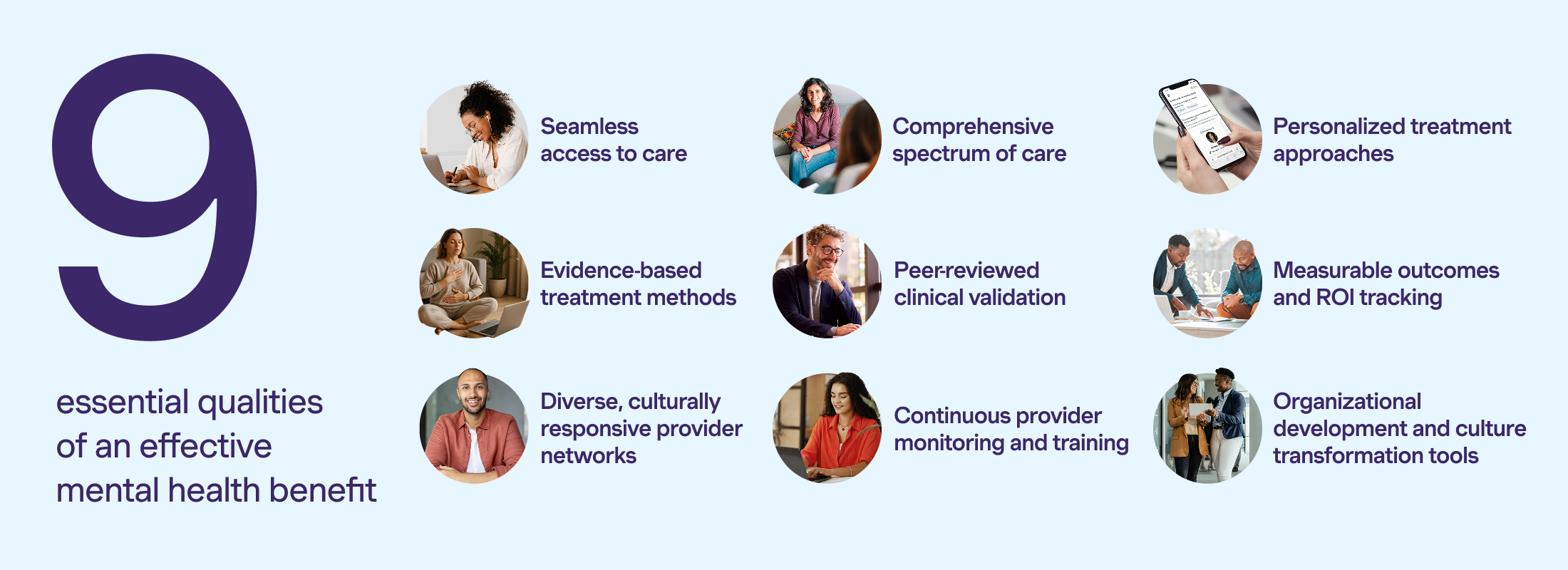About half of the world will experience a mental health issue at some point in their lives, driven by macro-level factors like geopolitical conflicts, economic instability, socio-demographic factors, or more personal reasons.
Despite the prevalence of mental health challenges—which have become a leading cause of disability—there has been chronic underinvestment in mental health services.
The most common barriers to global mental health benefits include:
- Diverse regional requirements
- Cultural stigma
- Language barriers
- Access and management across multiple locations and countries
- Ability to measure outcomes
Access to adequate mental health support has been an issue for decades. Hina Zaman, Senior Director of Global Care Operations at Spring Health, says, “For a long time, mental health has been seen as a poor cousin to physical health. What that means is that you have a shortage of solutions and clinicians on a per capita basis.
“This leads to a real care gap—individuals on the ground are either unable to access the care they need, or when they do, it’s a heavily convoluted, fragmented journey that adds to the anxiety, grief, or trauma that they might already be experiencing.”
This has resulted in increased demand from employees, with 81% considering mental health benefits important when looking for a new role.
“Offering mental health as a core benefit is almost table stakes now,” Zaman shares. “But offering an elevated mental health benefit that actually helps employees is what can set your organization apart and help you attract and keep top talent.”

The pros and cons of standardization vs. localization
When expanding mental health benefits globally, HR leaders often evaluate whether they want to approach their benefits through a standardized or localized approach.
Standardization means having the same mental health benefits and policies for all employees worldwide. It's administratively efficient and streamlines the workload for HR. This approach helps maintain a consistent standard of care and resources across all locations.
On the other hand, localization involves tailoring benefits to employees’ unique needs and preferences in various parts of the world. This includes making sure benefits and communication are culturally relevant and sensitive to local needs. Being in sync with local talent retention strategies, employee preferences, and feedback is crucial for a successful localized approach.
The benefits of a hybrid approach
Offering the highest quality care while still operating efficiently at a global level is possible by taking a hybrid approach: combining a standardized framework with localized aspects to fit the unique needs of different regions and acknowledge cultural norms and local languages.
Let’s look at Spring Health as an example. Measurement-based care is a central tenet of how we design and deliver care at Spring Health. Every member begins their care journey through a single front door, where they have access to a full spectrum of care services. From there, the services are highly personalized and localized to ensure each individual gets the care that is right for them.
Another example is our approach to building and growing our high-quality provider network across the globe. We have certain global operating principles and quality thresholds that we’ll maintain regardless of where we operate geographically. That includes rigorous vetting, interviewing, onboarding, training, and workflows.
But we also localize: we vet and curate local providers steeped in their local ecosystems and deeply familiar with cultural nuance.
Best practices to guide global expansion
Creating global benefits packages that are competitive, results-driven, scalable, tailored, and cost-effective is possible. We’ve found considering the following areas to be helpful:
- Benchmarking: Analyze what other organizations offer regarding benefits in each region. This helps you understand the competitive landscape.
- Standardization: Identify core benefits that can be standardized across all regions to ensure consistent access to essential services.
- Localization: Offer localized care, multilingual support, and culturally sensitive resources. Translation apps don’t cut it—you need local experts who understand the nuance of the language and culture.
- Talent needs: Explore the impact of expanding mental health benefits on employee retention and recruitment efforts globally.
- Leadership support: Reduce stigma by training leaders to discuss mental health issues, share personal stories, prioritize employee well-being, and actively support mental health initiatives.
- Education and training: Provide resources on mental health awareness, dealing with stigma, and recognizing mental health issues.
- Insights and outcomes: Continuously measure and evaluate clinical and financial outcomes to ensure your mental health benefits deliver value to your organization and employees globally.
The impact of a thriving global workforce
Offering comprehensive mental health benefits conveys a strong commitment to employee well-being and cultivates an environment rich in empathy, care, and gratitude. Providing these benefits clearly communicates that your employees are a top priority.
By addressing issues like burnout with proactive solutions like mental health support, organizations display a strong dedication to their employees. This boosts job satisfaction, engagement, productivity, and loyalty and ultimately leads to a culture people want to be a part of.
Taking a holistic view as leaders
“A few years ago, we were seeing mass resignations,” says Zaman. “Now we’re in a quiet quitting phase.” Burnout is a major catalyst, especially when there is a lack of mental health support. But it doesn’t have to be that way.
“When I look at an example, I look at the CEO of Brown & Brown, Powell Brown,” says Dr. Joel Axler, MD, FAPA, Partner, National Behavioral Health Leader at Brown & Brown. “He leads by example. He gives these videos every other week, talking about taking care of yourself, then taking care of your family, and then taking care of your job.”
Dr. Axler is a proponent of helping leaders worldwide understand that mental health is a critical component of overall health and that investing in it can also improve employee engagement and job satisfaction.
Boosting engagement and maximizing the use of benefits across global teams
Engagement is the foundation of a robust system for mental well-being and is critical to positive outcomes in mental health support.
Whenever we onboard a new company at Spring Health, we first strive to understand the employee populations that make up that workforce: who they are, their characteristics, their industry, and what they need. This informs our approach to tailored, localized marketing and engagement campaigns and interventions for each cohort.
The next step is ensuring all employees know about the available mental health benefits. We use multichannel strategies to reduce stigma, build awareness, and drive engagement. In addition to reaching employees with traditional methods like email, we offer resources to educate leaders on recognizing and responding if a team member is struggling.
The platform’s design, where employees access their benefits and the member experience, is also crucial and should be easy to use, which is why we guide members through the entire process, making sure they know where to find the right help.
Engagement is an ongoing effort, and we see it as the most important factor for good mental health outcomes and return on investment in the long run.
How to evaluate the success of global programs
Data tracking and reporting are crucial for the future of mental health care benefits. With data, we can measure how well we're helping people. At Spring Health, we measure outcomes and data across several areas:
- Utilization and engagement: How members use and engage with our services and convert through the care funnel.
- Access metrics: How quickly employees can get the care they need, whether access to Care Navigation support or therapy.
- Clinical outcomes: How an employee population is progressing in their care, including whether anxiety and depression scores are improving.
The future of global mental health benefits
As the demand for care continues to increase, we’re going to see more expansion of global mental health. Addressing barriers, choosing appropriate strategies, and evaluating the impact of global mental health benefits have never been more critical.
Investing in mental health initiatives has become imperative for the well-being of employees and the overall success of global businesses.
Watch the replay of our recent webinar to learn more about how you can strategically expand mental health care across your global workforce.

A Los Angeles native living in San Francisco the past decade, Chloe has managed product marketing and community development with early startups, fortune 500s, and government agencies, across various sectors, including law, entertainment, nonprofit, and technology. She is passionate about holistic wellbeing and mental health, and spends her free time coaching others in their career pivots, pursuing her graduate degree in Counseling Psychology, and enjoying the great outdoors.
.jpg)
.jpg)

.png)
.png)
.png)
.png)




.png)




.png)




